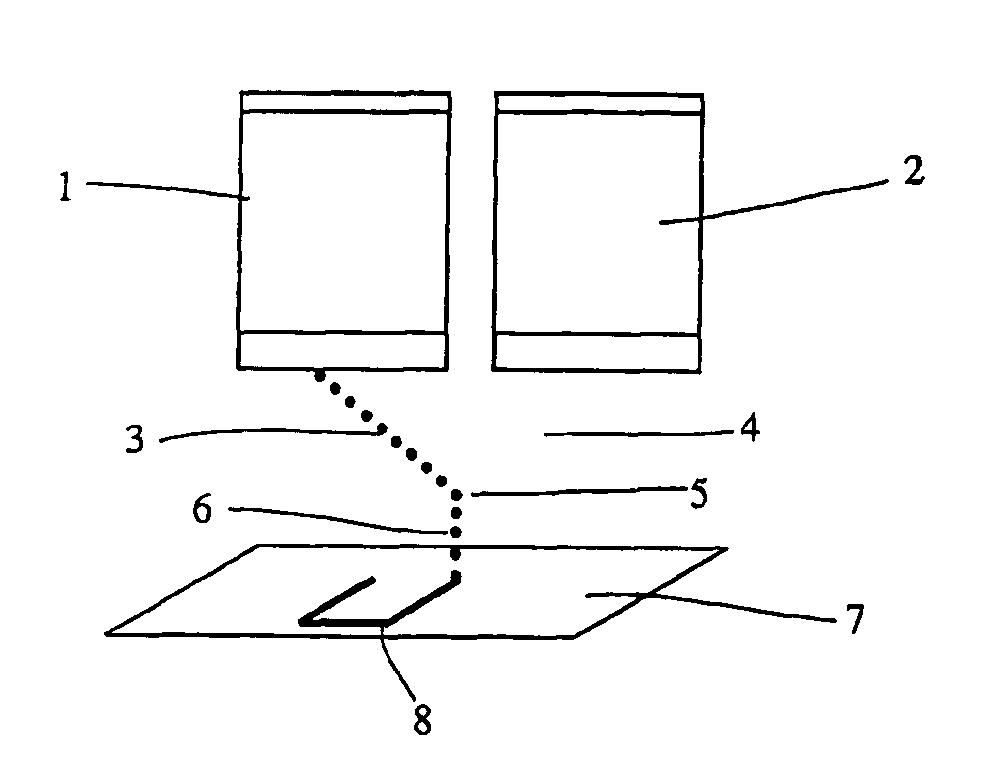Depositing solid materials
- Summary
- Abstract
- Description
- Claims
- Application Information
AI Technical Summary
Benefits of technology
Problems solved by technology
Method used
Image
Examples
first embodiment
[0018] In a first embodiment, the inkjet printer prints a PCB conductor by simply printing the metal salt and the reducing agent directly, instead of red and green ink (for example). The advantage is therefore in removing the need for the usual electroless bath process and its associated stabilisers. The PCB can be printed to the resolution of the inkjet printer, typically 20 μm at present as noted above.
second embodiment
[0019] In a second embodiment, reactive inks containing solvated species are combined to produce ceramic materials which may be in their final or alternatively “green” states. The “green” state refers to an intermediate ceramic material that has then to be sintered into its final form. Examples include hydroxides, carbonates or oxides of metals. The advantage of this approach is that reactions at the substrate result in improved material conformity with the substrate and the formation of a more dense material after this and subsequent processes, as compared to for example the printing of inks having the same solids contained in an organic binder. The ceramic layer can thus be built into two or three-dimensional structures. The resulting ceramic may have a wide range of properties, for example it may be an insulator such as calcium carbonate or a transparent conductor, such as zinc oxide. To print a three-dimensional article, a pair of fluids can be used which react to give a precipi...
third embodiment
[0020] In a third embodiment, sequential inkjet printing of a variety of materials is proposed, to build up multiple layers with differing properties. For example, inks could react together to form solid deposits of dielectrics such as ceramics or conductors hereinbefore described, or alternatively adhesive-like layers such as epoxy resins from two part inks. These types of materials may then be deposited sequentially in a user-defined way from an array of inkjet heads. The layers may also be combined with those formed more simply using dried inks from single inkjet heads. Thus, two processes could be combined for example to produce electrical components. In this way a conductive area could be formed, followed by a thin dielectric layer and further covered with conductor to form a capacitor as part of a PCB layout.
[0021] A further advantage of the present invention is that the process line may employ a larger series of inkjet heads beneath which substrates undergo a single pass at g...
PUM
| Property | Measurement | Unit |
|---|---|---|
| Fraction | aaaaa | aaaaa |
| Dielectric polarization enthalpy | aaaaa | aaaaa |
| Solubility (mass) | aaaaa | aaaaa |
Abstract
Description
Claims
Application Information
 Login to View More
Login to View More - R&D
- Intellectual Property
- Life Sciences
- Materials
- Tech Scout
- Unparalleled Data Quality
- Higher Quality Content
- 60% Fewer Hallucinations
Browse by: Latest US Patents, China's latest patents, Technical Efficacy Thesaurus, Application Domain, Technology Topic, Popular Technical Reports.
© 2025 PatSnap. All rights reserved.Legal|Privacy policy|Modern Slavery Act Transparency Statement|Sitemap|About US| Contact US: help@patsnap.com


